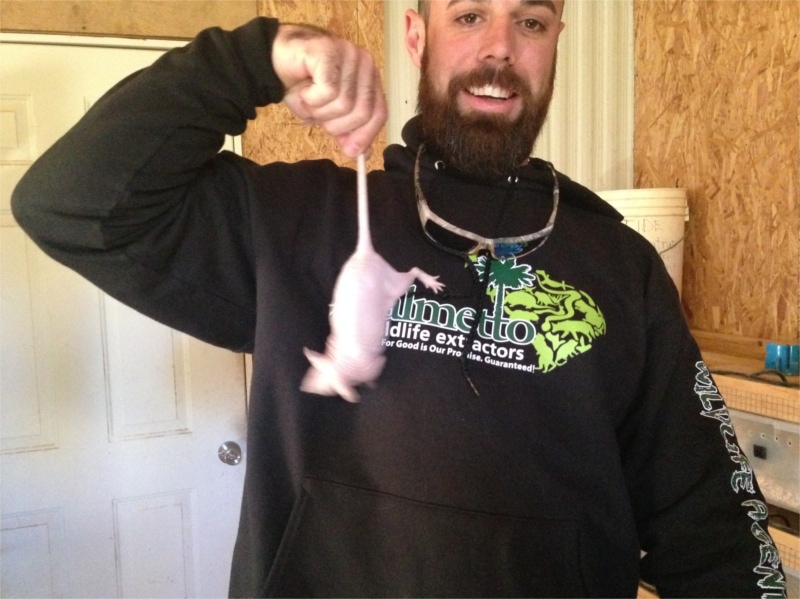As the cool weather approaches this fall and winter, so does the likelihood that rodents will be seeking warm nesting sites in the attics, garages and foundations of our homes and commercial buildings. In fact, some of our customers who live near wildfire areas have experienced an unseasonably early influx of these critters, driven from woods and fields by the smoke and flames.

Palmetto Wildlife Extractors Owner Justin Ludy shows off a rodent he caught for a client recently.
The two most common rodent invaders are mice and rats. The roof rat is the smaller of the two, averaging 5 to 10 ounces in weight, gray to white in color, with a pointed snout, long ears and a black tail as long as its body. The Norway rat is stockier, weighing 7 to 18 ounces, grayish in color, and with shorter ears and tail than the roof rat.
Rats also carry diseases such as murine typhus, leptospirosis, trichinosis, salmonellosis (food poisoning), ratbite fever and even plague that can be transmitted to humans and other animals.
The first signs of a rat infestation may appear in your yard or garden before the critters have moved indoors. Once they move into your yard, they will eventually move inside, so it’s preferable to catch them early.
Common signs of rat activity outdoors include:
- Droppings near pet food containers or dishes or recycling bins
- Nest materials in wood piles or brush piles
- Burrows near compost heaps or garbage containers
- Signs of digging under fences, sheds or doghouses
- The sight of a rat traveling utility lines or fence tops at dusk
- Rat carcasses in your outdoor pool or hot tub or dragged to the door by your family dog or cat
Indoors, you may hear noises coming from your attic, especially at dusk or dawn, or discover a nest inside drawers or behind boxes in your garage, or you may see smudges along walls, pipes or rafters.
Homeowners and business owners can take some common-sense measures to prevent rat infestations, including keeping pet food containers and garbage containers tightly sealed and the areas around them picked up and clean.
Bird Feeders are Attractive to Rats
Another of our customers, who had multiple bird feeders in her backyard, noticed that the seed-covered bird bell she hung in one corner of her yard would repeatedly disappear almost overnight. She would replace it, and by the next morning, it would be eaten down almost to the plastic hanger. Hungry birds, she thought. The one evening, she happened to be looking out the back door just as dark was settling in and heard a rustling in the leaves above the bird bell. Grabbing a flashlight, she quietly walked over to investigate. The beam of the flashlight revealed an acrobatic roof rat, hanging upside down from the branch, nibbling away.
Storing wood off the ground and eliminating clutter and debris from around building foundations also will discourage rat activity. Roof rats, such the acrobat caught eating our customer’s bird bell, may use overhanging tree branches, pergolas or dense shrubbery such as star jasmine or ivy as a highway to your roof, where they may find entry to your attic around eaves, pipes or chimney flashing. Trimming trees to leave 2 feet or more between plants and between branches and roof helps discourage these travels.
Sealing, screening or plugging openings around wiring conduit or pipes with steel wool or sheet metal, both around your roofline and at foundation level, also are effective at keeping rats out.
Once rats have moved in to your home or place of business, the best way to eliminate them is with the traditional snap traps. A major infestation may require the use of poison bait, which should only be administered by a trained pest control professional. Although customers sometimes request it, the use of live traps is not a good idea. Because the rats are not native to our environment, they cannot be released outdoors, where they pose a danger to humans, pets and property and—because they are an invasive species—to the native ecosystem. In some areas, rats have been known to decimate wild bird populations. Live traps also accumulate bodily waste from the rodents, creating a health hazard for our pest control technicians.

